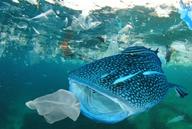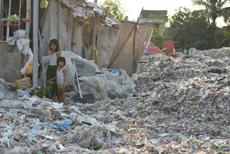The world is facing a plastic pollution crisis, affecting climate change, the natural environment, and human health. Since it first came into widespread use after WWII, more than 10 billion tons of plastic has been produced. An estimated 30% is currently in use.[1] Of the plastic that has been discarded, only about 9% was recycled and 12% incinerated. The rest – an estimated 60% of all plastic ever produced – has been landfilled or left in the natural environment. About 40% of current annual plastic production is for packaging and single-use items (bags, bottles, straws, bags), used for only minutes but that last in the environment for centuries or more.
Plastic is incredibly versatile and durable; it is made from fossil fuels, difficult to recycle, and doesn’t decompose. In landfills and the environment it eventually breaks into smaller and smaller pieces that litter the landscape, are consumed by wildlife, and ingested by people.[2] Every year, our oceans take in an estimated 5 million to 13 million tons of plastic from land-based sources.[3] Plastic particles (microplastics and even smaller nanoplastics) have been found in the deepest part of the oceans. On our present course, there will be more plastic than fish (by weight) in the oceans by 2050.[4]
Micro and nanoplastics are found in table salt, in bottled water, in food that we eat, and in house dust that we inhale.[5] Embedded in the particles are other toxic chemicals used to affect the pliability, color, and other characteristics of different types of plastics. It has been estimated that the average person ingests a credit card of plastic every week. The impact of ingesting plastic particles on human health is unknown. Read more about what the Maryland Chapter is doing to raise awareness and pass legislation to reduce single-use plastics and the harmful impacts.
The Story of Plastic
The Story of Plastic, a 95-minute documentary released on the 50th anniversary of Earth Day, takes a sweeping look at the man-made crisis of plastic pollution and the worldwide effect it has on the health of our planet and the people who inhabit it. Read more
- Panel discussion of "The Story of Plastic" for Maryland and local legislators, May 7, 2020
- Resources on Plastic Pollution Solutions, from the panelists

Statewide Plastic Bag Ban Nearly Passes Maryland’s 2020 General Assembly
The 2020 Plastics and Packaging Reduction Act, as introduced by Del. Brooke Lierman (HB209) and Sen. Malcolm Augustine (SB331), would have prohibited retailers from providing plastic carryout shopping bags to customers at the point of sale and required retailers to charge at least 10 cents for other carryout bags. It also would have established a working group to study and make recommendations on actions to reduce plastic and single-use container waste in Maryland. Read more
- Fact sheet
- Sierra Club testimony
- Plastics and Packaging Reduction Act (HB209/SB331)[6]
- Original bill (first reader – Plastic and Packaging Reduction Act)
- Amended bill (third reader – renamed Plastic Bag Reduction Act)
- Webinar
[1] Geyer, R., J. R. Jameck, K. L. Law. 2017. “Production, use, and fate of all plastics ever made,” Science Advances 3, e1700782. Shares calculated off of 2015 estimates.
[2] Loria, Kevin. 2020. “Special Report: Think you don’t eat plastic?” Consumer Reports, vol. 85(6): 26-35.
[3] Jambeck, Jenna et al. 2015. “Plastic waste inputs from land into the ocean,” Science 347, no. 6223: 768-771.
[4] https://www.weforum.org/press/2016/01/more-plastic-than-fish-in-the-ocean-by-2050-report-offers-blueprint-for-change/
[5] Loria, op cit.
[6] The House and Senate bills were identical and had identical amendments; the links are to HB209.
